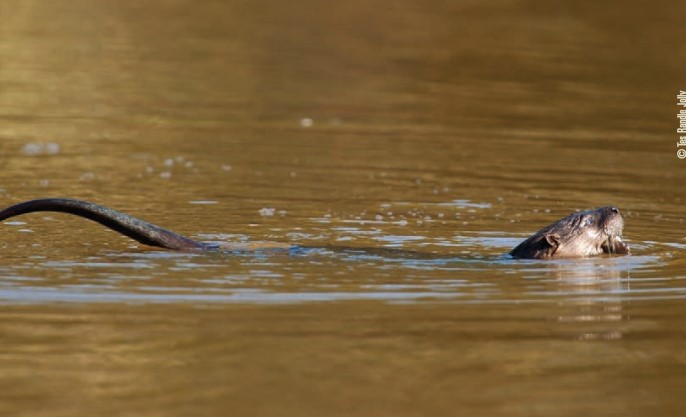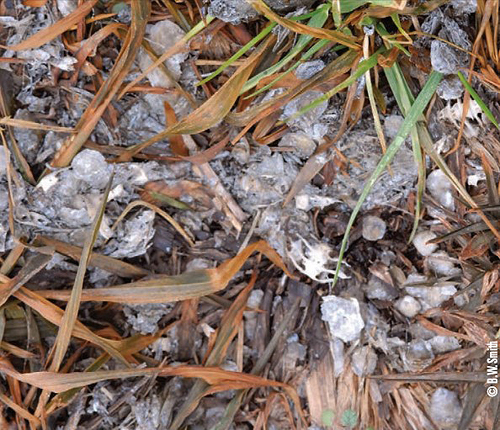Barry W. Smith | Originally published in GameKeepers: Farming for Wildlife Magazine
“I’ve never seen evidence of poaching in my lake,” stated the pond owner. “I don’t know why my big fish have disappeared.”
There are four legged poachers that are probably more effective catching your fish at night than are your neighbors.
“Otters are effective poachers and efficient fishers. They utilize the cover of darkness, are silent predators and leave little sign of their presence,” says wildlife biologist Ashley Lovell, of the USDA Animal Damage Control office in Montgomery, Ala.
Nocturnal Predators

According to Lovell, otters are primarily nocturnal predators but occasionally may be sighted swimming or feeding in the lake during dawn or dusk. They may travel as a lone male or a family group of four or more animals. They frequent lakes and ponds most often during the fall and winter, primarily November through February. They travel creeks and small ditches in search of food sources and may eat everything from crayfish and frogs to your largest bass and grass carp. Males may travel long distances during this period of time, searching for females receptive to breeding.

dam. Otter trails are usually 6 to 7 inches wide, as opposed
to a beaver trail which is usually 10 to 12 inches wide and
may be slick with mud.
Males grow the largest, obtaining weights of 30 pounds. Females are slightly smaller, averaging 20 to 25 pounds. The female is the solitary provider for the family of up to five pups, which are usually born in the spring. The young are natural swimmers and the female teaches them to swim and forage for food items at 2 months of age. They usually remain with the female until they are approximately 8 months old. Otters will often make their homes in muskrat or beaver dens, evicting or killing the previous occupants.
Otters are seldom permanent residents of your lake; they visit and feed for several days, or even weeks, then move to another location. They usually travel to and from your lake each night to feed, returning to a temporary home base near you. However, once the first group leaves, another group or individual may visit. A professional trapper once told of catching 25 otter from behind the dam of a 25- acre lake in Macon County, Ala., during one trapping season.
Seldom Detected
Walter Beshears, a wildlife biologist and professional trapper from Montgomery, Ala., has caught many otters.
“Most pond owners never recognize otter sign,” says Beshears. “Beavers are easy for most people to recognize, as they girdle trees, leave freshly cut branches in the water and have very wide, often muddy slides or trails where they enter the lake. Otters will make a narrow trail, 6 or 7 inches wide, and may never wear the grass down to the soil. They typically leave no sign, except for fecal deposits (scat) that often contain fish scales and bones.”
“These scat deposits are oftentimes found on the backside of the pond dam, out of normal sight. Many lake owners do not fish during the winter and if they check on their lake it is usually from the porch of their cabin or out the window of their truck. Otter damage often goes undetected,” claims Beshears.
Looking for Otter Sign

deposited on the back side of the dam, multiple piles of scat indicate
frequent otter activity.
Beshears looks for otter sign by carefully inspecting the backside of the lake dam for narrow trails and areas of scat deposit. If otters are actively feeding in the lake, inspecting during the early morning will show trails that have dew off the grass, making the trails look very distinct. Inspecting piles of scat can also reveal how recently otters have visited the lake.
“If the only scat you find is dry and powder-white, the otter has long-since left your lake,” says Beshears. “If the scat is moist and dark, you have a recent visitor.” Beshears says to look for fish scales and bones in the scat to help identify it, adding that large scales means it has eaten a large fish.
How Much Damage?
The late O.L. Green, fisheries biologist and one of the pioneers of the catfish industry in West Alabama, told of a group of otters decimating a pond of brood catfish on a private farm in that region. A mature otter can consume 10 to 20 pounds of fish a night, if the fish are concentrated enough for them to catch. They are clever nocturnal predators and will often work together to herd a school of fish into the shallows where they are easy prey for a group of hungry otters.
In recreational ponds, fish are more difficult for otters to catch, but often they will target the larger fish– such as bass, catfish or grass carp. Frequent otter visits during a period of three to four months can have a significant cumulative effect on the population of adult fish, especially in smaller lakes, such as those less than 10 acres.
What to Do?
In many states, otter are protected or can only be trapped during specific trapping seasons. Check with your state game and fish agency for regulations that may apply to your location as permits or licenses may be required.
Otters were once prized furbearers, bringing more than $100 per pelt, but market prices have been greatly depressed for the last five years, reducing trapping pressure. Weekly inspections of your lake during the months of November through February can alert you to unwanted visitors.
Walk the back slope of the dam and look for small trails and areas of otter droppings. Once you have identified the presence of these night poachers, call a professional trapper to help with the problem.
“It is much more difficult to catch an otter after the lake owner has made the animal trap-shy,” says professional trapper Walter Beshears.
“Most lake owners have very little knowledge of trapping techniques and their trapping efforts merely educate the animals. Unless you have previous experience capturing otter, call a professional first,” urges Beshears.
Conibear traps, used to capture beaver and otter, are dangerous and can inflict serious wounds to a novice trapper, or can kill the family pet if improperly set.
Your lake does not have to backup to a creek for you to have otter visit it. Otter can travel distances overland in search of food or mates. During the winter, most lakes and ponds are full and rain overflow will run through a ditch until it reaches a creek or larger ditch. These are otter highways that lead directly to their private buffet, your lake!
Be aware of night poachers and find out who is fishing your pond!
Barry W. Smith is a Certified Fisheries Scientist and co-owner of American Sport Fish Hatchery in Montgomery, Ala.






























